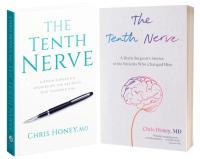You are only seeing posts authors requested be public.
Register and Login to participate in discussions with colleagues.
Books
The Tenth Nerve: a brain surgeon's stories of the patients who changed him
Public
 Penguin Random House Canada has published this book and I hope you will enjoy it.
Penguin Random House Canada has published this book and I hope you will enjoy it.
These are the stories of seven brave patients whose close encounters changed me into a better person and surgeon. It is a book about discoveries—both medical discoveries (including two new diseases) that I have provided my patients and personal discoveries that my patients have prompted in me. The scalpel can only go so deep, and technical skill can only take you so far. Real understanding of an illness requires listening and genuine care. The Tenth Nerve is a book about curiosity, the wonder of the human brain, and the courage of a few remarkable patients.
The I Ching or Book Of Changes
Public
 The I Ching, or Book Of Changes, is an ancient Chinese book. While there are many translations, the German translation by Richard Wilhelm rendered into English by Cary F. Baynes (1950) has become a well respected classic. The book includes a foreword by CG Jung, psychiatrist and psychoanalyst, who has elsewhere described using the I Ching in his psychiatric practice from time to time. An electronic version of the text related to the hexagrams (the oracle), from the first part of the translation, can be viewed online or downloaded using the link below.
The I Ching, or Book Of Changes, is an ancient Chinese book. While there are many translations, the German translation by Richard Wilhelm rendered into English by Cary F. Baynes (1950) has become a well respected classic. The book includes a foreword by CG Jung, psychiatrist and psychoanalyst, who has elsewhere described using the I Ching in his psychiatric practice from time to time. An electronic version of the text related to the hexagrams (the oracle), from the first part of the translation, can be viewed online or downloaded using the link below.
The Bhagavad Gita Comes Alive
Public
 Dr Chris Sedegreen.
Dr Chris Sedegreen.
Some time before the Christmas holiday a colleague mentioned a book, The Bhagavad Gita Comes Alive, on the Doclounge listserve. I’d like to thank him for bringing this lovely book to our attention. I ordered and received the paperback version (somewhat cheaper than the hard cover, but in retrospect I wish I'd ordered the hard cover). This publication is beautifully printed.
Book Review: The Last Plane by Robert Hirzer
Public
 This is a good book, a well written novel. It is the first book by the author, Robert Hirzer, a physician and GP whose practice was in the area served by the Royal Columbian Hospital in New Westminster, BC - the hospital where he interned and where he was on staff in the days when doctors not only worked in their offices but also cared for patients in hospital.
This is a good book, a well written novel. It is the first book by the author, Robert Hirzer, a physician and GP whose practice was in the area served by the Royal Columbian Hospital in New Westminster, BC - the hospital where he interned and where he was on staff in the days when doctors not only worked in their offices but also cared for patients in hospital.
The novel, while it is a work of fiction, is a reflection following the death of his father on the lives of his family spanning four generations including his grandparents, his parents, his own generation with brief mention of his children. In one short chapter he describes a day in the life of a GP that rings true for many who practiced in days when full spectrum general practice was the norm. But, most of the novel is about the lives of his parents through their childhood in Austria into youth and young adulthood as the second world war consumed those years.
Viscose rayon and health effects on workers during manufacturing
Public
 Paul Blanc, University of California professor of medicine, chair of occupational and environmental medicine and author of the book "Fake Silk - The Lethal History of Viscose Rayon" has written about the dangers and health effects to workers in the manufacturing of these materials.
Paul Blanc, University of California professor of medicine, chair of occupational and environmental medicine and author of the book "Fake Silk - The Lethal History of Viscose Rayon" has written about the dangers and health effects to workers in the manufacturing of these materials.
In a recent radio interview on CBC The Current he talks of the dangers and medical effects of exposure to carbon disulfide used in the manufacturing process and the diversity of products. He speaks of places where there are better working conditions and worker safeguards while there are other places where this is not so.
The toxic effects of carbon disulfide are dramatic and onset early. It easily travels into brain tissue and causes insanity along with other medical problems.
The 3D defence; Deny, Delay, Destroy.
Public
 Book Review
Book Review
The book, "Corporate Personality Disorder, Surviving & Saving Sick Organizations" by Eli Sopow, PhD draws heavily on medical practice examples and describes how "at the core of the Organizational Family Tree is the Triangle of Trust, which combines authority, responsibility, and accountability through a harmonious balance of communications, cooperation, and connectivity to others." He offers critical success factors for each of these six factors.




